Effects of Using Different Sources of Remote Sensing and Geographic Information System Data on Urban Stormwater 2D–1D Modeling
Abstract
:1. Introduction
2. Materials and Methods
2.1. Model Description
2.2. Study Site
2.3. Rainfall Event Data
2.4. LiDAR and Topographic Data
2.5. Landuse Information
2.6. Configuration of Parameters for Urban Areas
3. Results and Discussion
3.1. Parameter Values and Reference Simulations
3.2. Effects of Using Free Access Topographic and Landuse Data
3.3. Is the Free Access GIS Data Sufficient for Urban 2D–1D Stormwater Modeling?
4. Conclusions
Acknowledgments
Author Contributions
Conflicts of Interest
References
- Di Baldassarre, G.; Uhlenbrook, S. Is the current flood of data enough? A treatise on research needs for the improvement of flood modelling. Hydrol. Process. 2012, 26, 153–158. [Google Scholar] [CrossRef]
- Bates, P.D. Integrating remote sensing data with flood inundation models: How far have we got? Hydrol. Process. 2012, 26, 2515–2521. [Google Scholar] [CrossRef]
- Veleda, S.; Martínez-Graña, A.; Santos-Francés, F.; Sánchez-SanRoman, J.; Criado, M. Analysis of the Hazard, Vulnerability, and Exposure to the Risk of Flooding (Alba de Yeltes, Salamanca, Spain). Appl. Sci. 2017, 7, 157. [Google Scholar] [CrossRef]
- Gallegos, H.A.; Schubert, J.E.; Sanders, B.F. Two-dimensional, high-resolution modeling of urban dam-break flooding: A case study of Baldwin Hills, California. Adv. Water Resour. 2009, 32, 1323–1335. [Google Scholar] [CrossRef]
- Horritt, M.S.; Di Baldassarre, G.; Bates, P.D.; Brath, A. Comparing the performance of a 2-D finite element and a 2-D finite volume model of floodplain inundation using airborne SAR imagery. Hydrol. Process. 2007, 21, 2745–2759. [Google Scholar] [CrossRef]
- Fletcher, T.D.; Andrieu, H.; Hamel, P. Understanding, management and modelling of urban hydrology and its consequences for receiving waters: A state of the art. Adv. Water Resour. 2013, 51, 261–279. [Google Scholar] [CrossRef]
- Salvadore, E.; Bronders, J.; Batelaan, O. Hydrological modelling of urbanized catchments: A review and future directions. J. Hydrol. 2015, 529 Pt 1, 62–81. [Google Scholar] [CrossRef]
- Fewtrell, T.J.; Duncan, A.; Sampson, C.C.; Neal, J.C.; Bates, P.D. Benchmarking urban flood models of varying complexity and scale using high resolution terrestrial LiDAR data. Phys. Chem. Earth Parts ABC 2011, 36, 281–291. [Google Scholar] [CrossRef]
- Djordjević, S.; Prodanović, D.; Maksimović, C.; Ivetić, M.; Savić, D. SIPSON—Simulation of interaction between pipe flow and surface overland flow in networks. Water Sci. Technol. J. Int. Assoc. Water Pollut. Res. 2005, 52, 275–283. [Google Scholar]
- Kidmose, J.; Troldborg, L.; Refsgaard, J.C.; Bischoff, N. Coupling of a distributed hydrological model with an urban storm water model for impact analysis of forced infiltration. J. Hydrol. 2015, 525, 506–520. [Google Scholar] [CrossRef]
- Sto Domingo, N.D.; Refsgaard, A.; Mark, O.; Paludan, B. Flood analysis in mixed-urban areas reflecting interactions with the complete water cycle through coupled hydrologic-hydraulic modelling. Water Sci. Technol. J. Int. Assoc. Water Pollut. Res. 2010, 62, 1386–1392. [Google Scholar] [CrossRef] [PubMed]
- Vojinovic, Z.; Tutulic, D. On the use of 1D and coupled 1D-2D modelling approaches for assessment of flood damage in urban areas. Urban Water J. 2009, 6, 183–199. [Google Scholar] [CrossRef]
- DHI MIKE by DHI Software. Reference Manuals for MIKE FLOOD 2008. Available online: https://www.mikepoweredbydhi.com/products/mike-flood (accessed on 31 August 2017).
- Innovyze Ltd InfoWorks 2D—Collection Systems Technical Review 2011. Available online: http://www.innovyze.com/products/infoworks_icm/ (accessed on 31 August 2017).
- Velleux, M.L.; England, J.F.; Julien, P.Y. TREX: Spatially distributed model to assess watershed contaminant transport and fate. Sci. Total Environ. 2008, 404, 113–128. [Google Scholar] [CrossRef] [PubMed]
- Lhomme, J.; Bouvier, C.; Perrin, J.-L. Applying a GIS-based geomorphological routing model in urban catchments. J. Hydrol. 2004, 299, 203–216. [Google Scholar] [CrossRef]
- Green, W.H.; Ampt, G.A. Studies on Soil Phyics. J. Agric. Sci. 1911, 4, 1–24. [Google Scholar] [CrossRef]
- Preismann, A. Propagation of translatory waves in channels and rivers. In Proceedings of the 1st Congress of French Association for Computation, Grenoble, France, 20 September 1961; pp. 432–443. [Google Scholar]
- Hong, Y.; Bonhomme, C.; Le, M.-H.; Chebbo, G. A new approach of monitoring and physically-based modelling to investigate urban wash-off process on a road catchment near Paris. Water Res. 2016, 102, 96–108. [Google Scholar] [CrossRef] [PubMed]
- Paparoditis, N.; Papelard, J.-P.; Cannelle, B.; Devaux, A.; Soheilian, B.; David, N.; Houzay, E. Stereopolis II: A multi-purpose and multi-sensor 3D mobile mapping system for street visualisation and 3D metrology. Rev. Fr. Photogramm. Télédétec. 2012, 200, 69–79. [Google Scholar]
- Hervieu, A.; Soheilian, B. Semi-Automatic Road/Pavement Modeling using Mobile Laser Scanning. ISPRS Ann. Photogramm. Remote Sens. Spat. Inf. Sci. 2013, II-3/W3, 31–36. [Google Scholar] [CrossRef]
- Guigues, L.; Cocquerez, J.P.; Men, H.L. Scale-Sets Image Analysis. Int. J. Comput. Vis. 2006, 68, 289–317. [Google Scholar] [CrossRef]
- Xiao, Q.; McPherson, E.G.; Simpson, J.R.; Ustin, S.L. Rainfall interception by Sacramento’s urban forest. J. Arboric. USA 1998, 24, 235–244. [Google Scholar]
- Rossman, L.A. Storm Water Management Model User’s Manual Version 5.0; National Risk Management Research and Development U.S. Environmental Protection Agency: Cincinnati, OH, USA, 2010; p. 45268.
- Nash, J.E.; Sutcliffe, J.V. River flow forecasting through conceptual models part I—A discussion of principles. J. Hydrol. 1970, 10, 282–290. [Google Scholar] [CrossRef]
- Tsihrintzis, V.A.; Hamid, R. Modeling and management of urban stormwater runoff quality: A review. Water Resour. Manag. 1997, 11, 136–164. [Google Scholar] [CrossRef]
- Hong, Y.; Bonhomme, C.; Le, M.-H.; Chebbo, G. New insights into the urban washoff process with detailed physical modelling. Sci. Total Environ. 2016, 573, 924–936. [Google Scholar] [CrossRef] [PubMed]
- Hervieu, A.; Soheilian, B.; Brédif, M. Road Marking Extraction Using a MODEL & DATA-DRIVEN Rj-Mcmc. ISPRS Ann. Photogramm. Remote Sens. Spat. Inf. Sci. 2015, 47–54. [Google Scholar] [CrossRef]
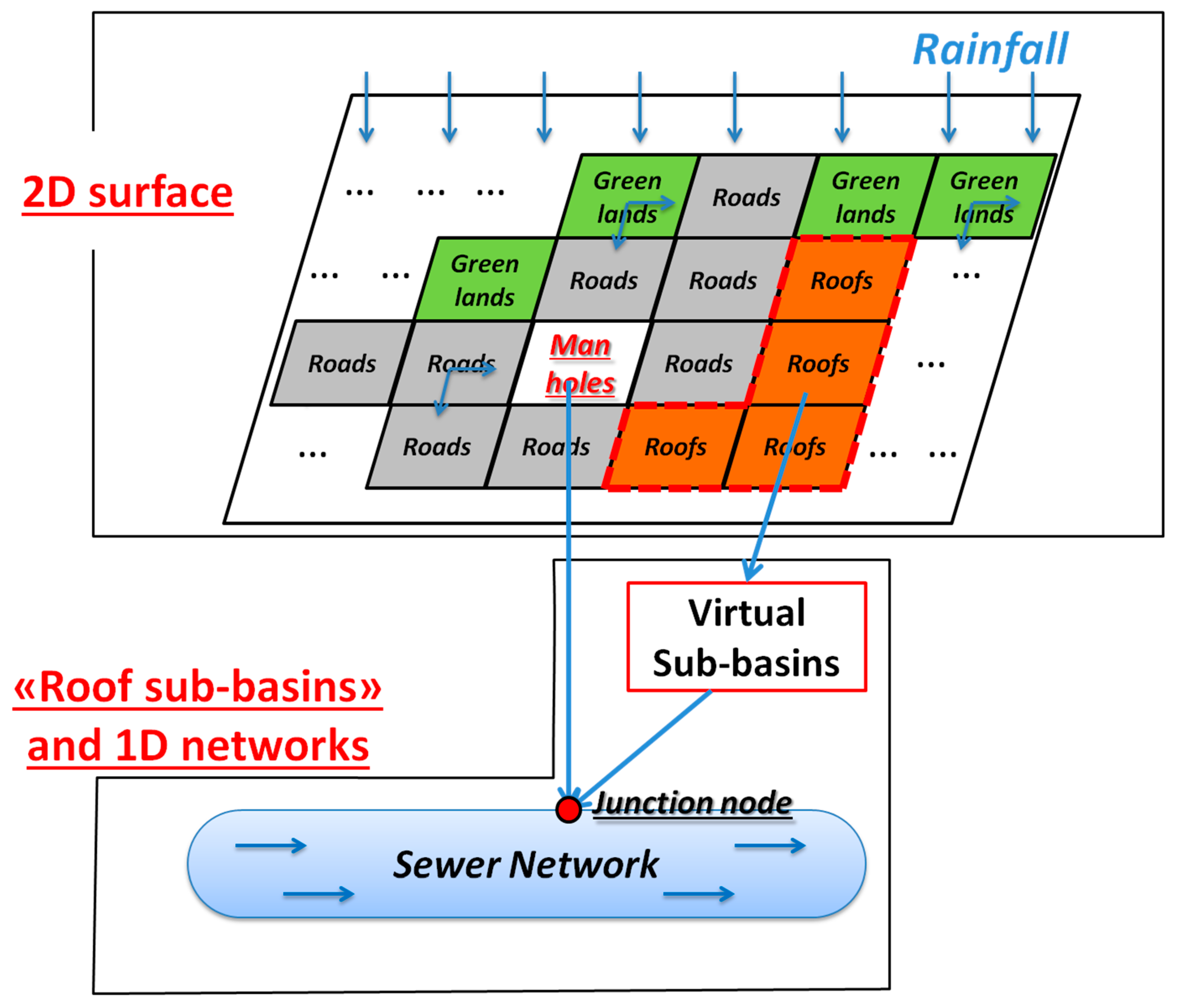
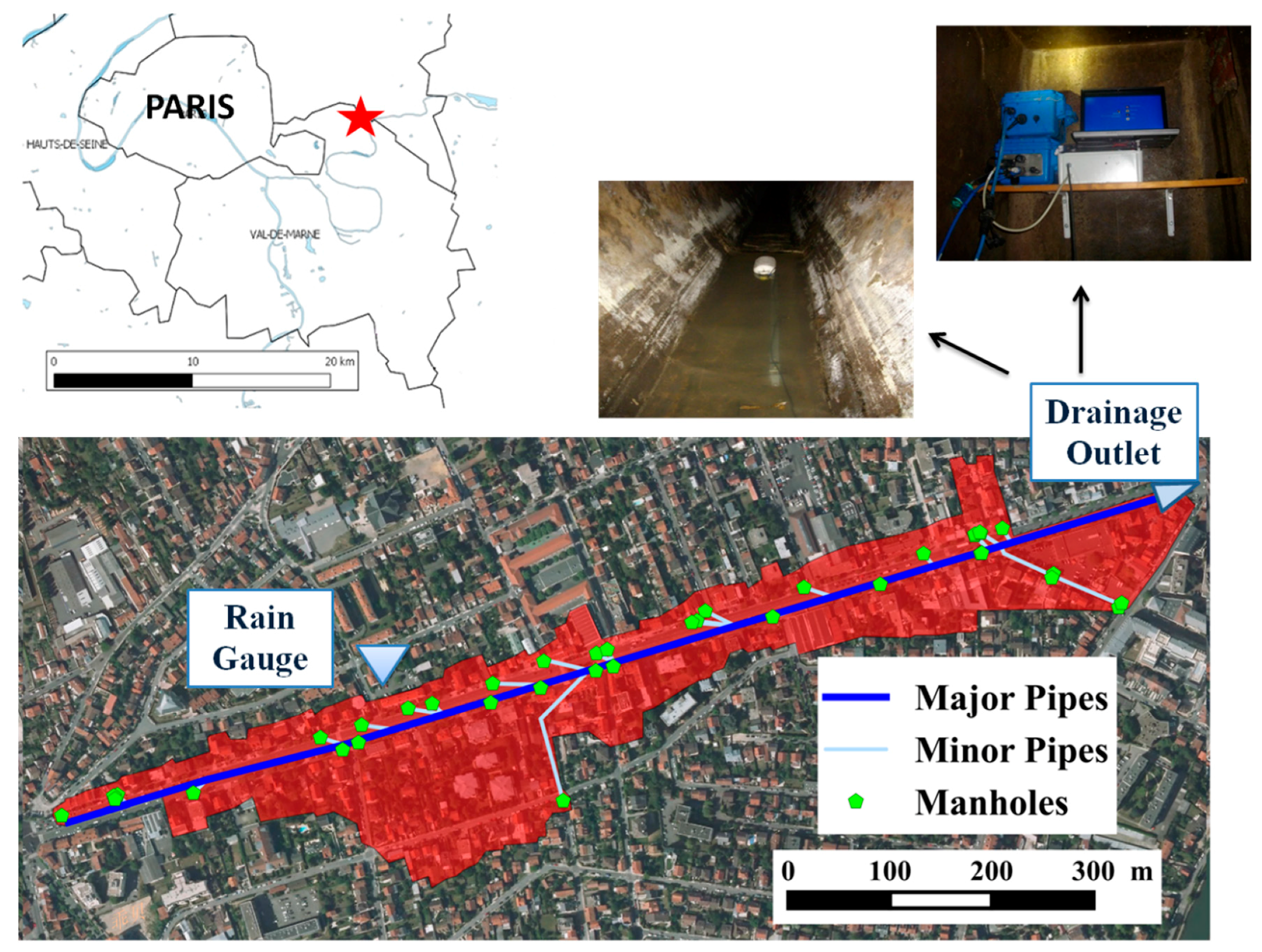

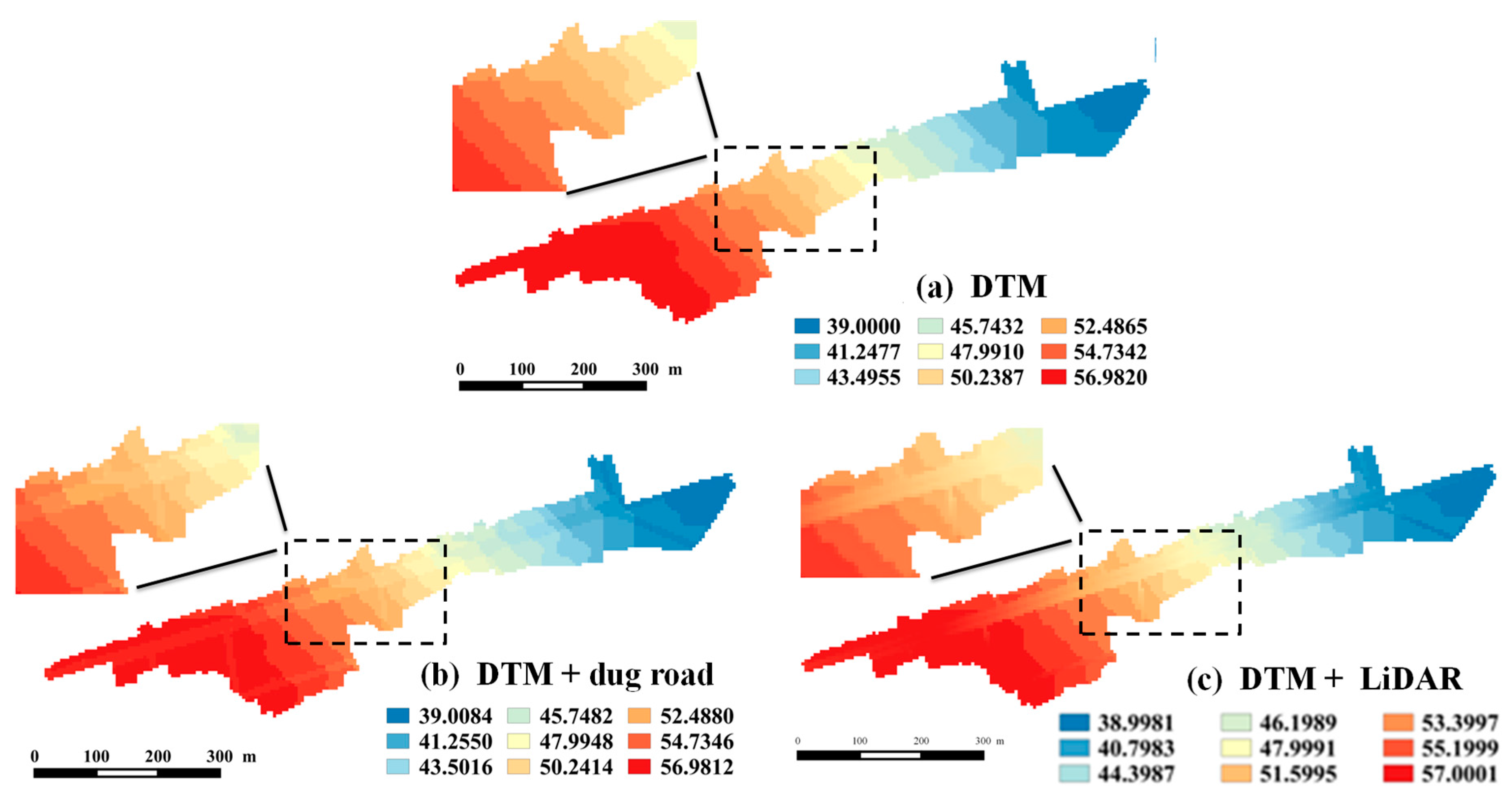

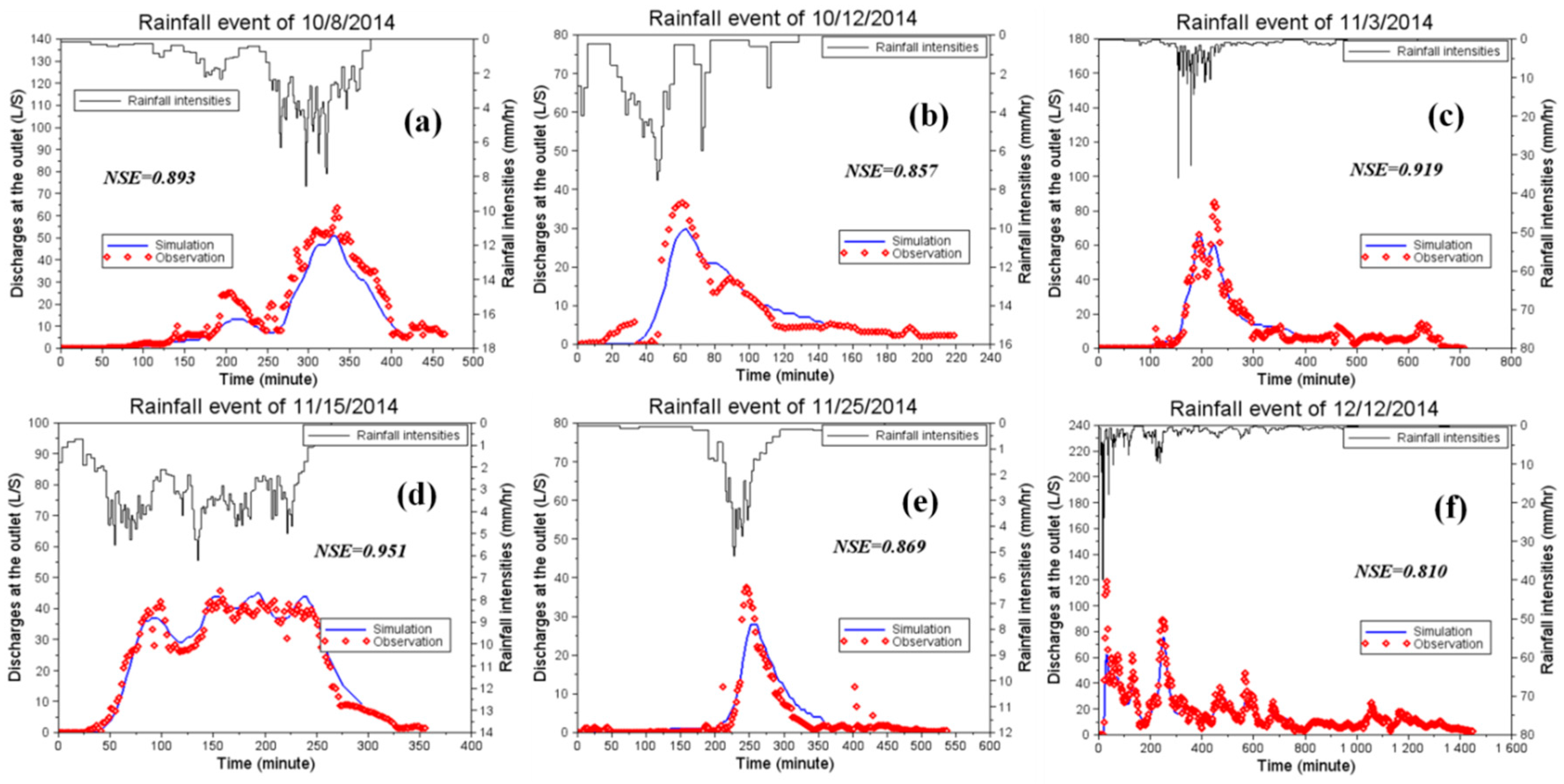
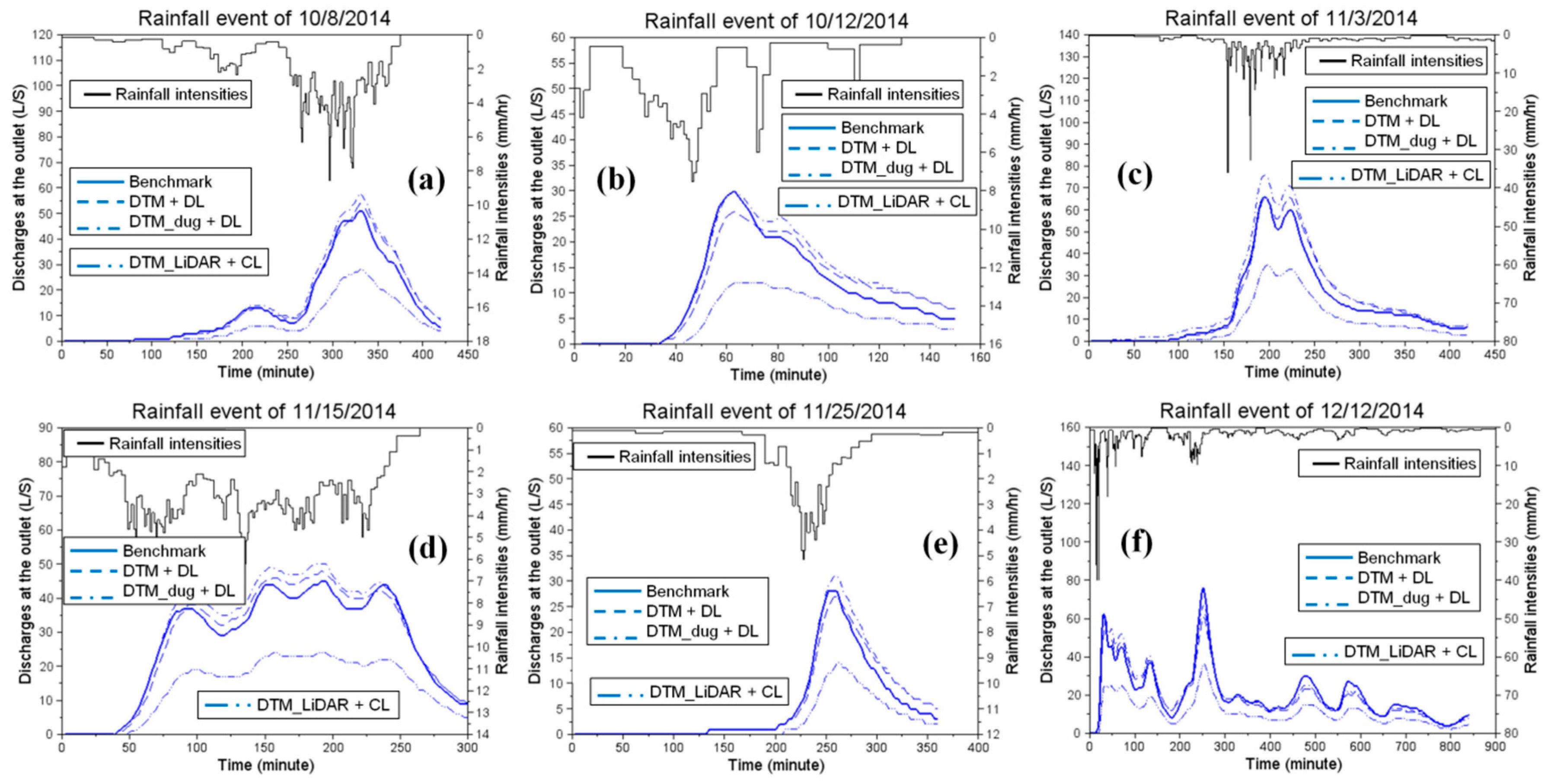
| Rainfall Date | Rainfall Depth (mm) | Mean Intensity (mm/h) | Max Intensity (mm/h) | Duration (h) |
|---|---|---|---|---|
| 8 October 2014 | 4.86 | 1.52 | 8.57 | 6.17 |
| 12 October 2014 | 3.60 | 1.68 | 7.50 | 2.14 |
| 3 November 2014 | 4.60 | 1.33 | 36.0 | 10.3 |
| 15 November 2014 | 9.27 | 2.81 | 6.21 | 4.41 |
| 25 November 2014 | 2.86 | 1.32 | 5.14 | 3.33 |
| 12 December 2014 | 4.15 | 1.28 | 40.0 | 22.6 |
| 2D-Surface Modeling | ||
|---|---|---|
| Impervious surface (road, sidewalk, etc.) | Pervious surfaces (grass, trees, etc.) | |
| Initial loss (mm) | 0.5 | 3 |
| Suction head at the wetting front (m) | 0.01 | 0.05 |
| Residual soil moisture content | 0.1 | 0.4 |
| Manning’s N values for surface runoffs | 0.015 | 0.2 |
| Saturated hydraulic conductivity (m/s) | 1.0 × 10−8 | 1.0 × 10−5 |
| Initial loss (mm) | 0.5 | 3 |
| 1D sewer and roof modeling | ||
| Manning’s N for sewer networks | 0.014 | |
| Manning’s N for virtual sub-basins | 0.012 | |
| Tested Scenarios vs. Reference Scenario | DTM + DL vs. DTM_LiDar + DL | DTM_dug + DL vs. DTM_LiDar + DL | DTM_LiDAR + CL vs. DTM_LiDAR + DL | |||
|---|---|---|---|---|---|---|
| Performance indicator | MD (L·s−1) | RMD (%) | MD (L·s−1) | RMD (%) | MD (L·s−1) | RMD (%) |
| 8 October 2014 | 1.96 | 14.7 | 1.31 | 9.33 | 6.32 | 47.6 |
| 12 October 2014 | 1.72 | 16.5 | 1.70 | 16.3 | 5.34 | 51.3 |
| 3 November 2014 | 3.76 | 23.3 | 1.99 | 12.3 | 7.54 | 46.9 |
| 15 November 2014 | 2.80 | 10.5 | 1.94 | 7.30 | 12.5 | 47.1 |
| 25 November 2014 | 0.94 | 17.4 | 0.86 | 15.9 | 2.76 | 51.1 |
| 12 December 2014 | 2.32 | 11.3 | 2.31 | 11.2 | 9.58 | 46.6 |
© 2017 by the authors. Licensee MDPI, Basel, Switzerland. This article is an open access article distributed under the terms and conditions of the Creative Commons Attribution (CC BY) license (http://creativecommons.org/licenses/by/4.0/).
Share and Cite
Hong, Y.; Bonhomme, C.; Soheilian, B.; Chebbo, G. Effects of Using Different Sources of Remote Sensing and Geographic Information System Data on Urban Stormwater 2D–1D Modeling. Appl. Sci. 2017, 7, 904. https://doi.org/10.3390/app7090904
Hong Y, Bonhomme C, Soheilian B, Chebbo G. Effects of Using Different Sources of Remote Sensing and Geographic Information System Data on Urban Stormwater 2D–1D Modeling. Applied Sciences. 2017; 7(9):904. https://doi.org/10.3390/app7090904
Chicago/Turabian StyleHong, Yi, Céline Bonhomme, Bahman Soheilian, and Ghassan Chebbo. 2017. "Effects of Using Different Sources of Remote Sensing and Geographic Information System Data on Urban Stormwater 2D–1D Modeling" Applied Sciences 7, no. 9: 904. https://doi.org/10.3390/app7090904





